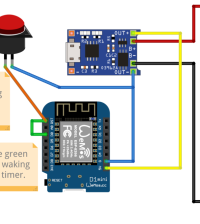- How to Adjust X and Y Axis Scale in Arduino Serial Plotter (No Extra Software Needed)Posted 4 months ago
- Elettronici Entusiasti: Inspiring Makers at Maker Faire Rome 2024Posted 4 months ago
- makeITcircular 2024 content launched – Part of Maker Faire Rome 2024Posted 6 months ago
- Application For Maker Faire Rome 2024: Deadline June 20thPosted 8 months ago
- Building a 3D Digital Clock with ArduinoPosted 1 year ago
- Creating a controller for Minecraft with realistic body movements using ArduinoPosted 1 year ago
- Snowflake with ArduinoPosted 1 year ago
- Holographic Christmas TreePosted 1 year ago
- Segstick: Build Your Own Self-Balancing Vehicle in Just 2 Days with ArduinoPosted 1 year ago
- ZSWatch: An Open-Source Smartwatch Project Based on the Zephyr Operating SystemPosted 1 year ago
Microsoft Open Sources Azure IoT Edge

At Build 2017, Microsoft introduced Azure IoT Edge, which lets edge devices run AI, Azure services, and custom logic to not just generate insights, but act on them both locally and autonomously. Microsoft has since deployed various Azure services to the edge, and now it’s gearing up to push more.
But first Microsoft is open-sourcing the Azure IoT Edge runtime to let its customers modify, debug, and get more control over edge applications. Azure IoT Edge already supports an “open ecosystem of services in containers,” and Microsoft hopes the community can dream up new use cases if they can examine exactly how the runtime works.
“Now devices can act immediately on real-time data — whether it be recognizing a crack in a pipe from an aerial view or predicting equipment failure before it happens,” Microsoft said in its announcement Wednesday. “As we evolve toward a world of ubiquitous computing, the design of the IoT solution spanning hardware, edge and cloud must be consistent and secure to drive real impact.”
Microsoft is also adding several new capabilities developed over the solution’s one-year preview period, including broad language support for module SDKs, tooling for Visual Studio Code in the form of the Azure IoT Edge extension, a Visual Studio Team Services CI/CD pipeline, and support for the Moby container management system.
Those new features expand the actual functionality as the integration with Microsoft AI services, support for Kubernetes container orchestration, new partnerships, and third-party hardware integrations including DJI drones and the Qualcomm vision AI developer kit.
















